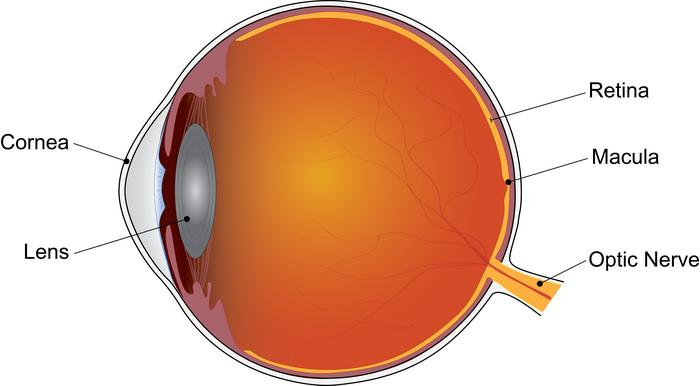In a new analysis of data, researchers at the National Institutes of Health (NIH) have found that taking a daily supplement containing antioxidant vitamins and minerals slows progression of late-stage dry age-related macular degeneration (AMD), potentially helping people with late-stage disease preserve their central vision. Researchers reviewed the original retinal scans of participants in the Age-Related Eye Diseases Studies (AREDS and AREDS2) and found that, for people with late-stage dry AMD, taking the antioxidant supplement slowed expansion of geographic atrophy regions towards the central foveal region of the retina. The study was published in the journal Ophthalmology.

Credit: National Eye Institute
In a new analysis of data, researchers at the National Institutes of Health (NIH) have found that taking a daily supplement containing antioxidant vitamins and minerals slows progression of late-stage dry age-related macular degeneration (AMD), potentially helping people with late-stage disease preserve their central vision. Researchers reviewed the original retinal scans of participants in the Age-Related Eye Diseases Studies (AREDS and AREDS2) and found that, for people with late-stage dry AMD, taking the antioxidant supplement slowed expansion of geographic atrophy regions towards the central foveal region of the retina. The study was published in the journal Ophthalmology.
“We’ve known for a long time that AREDS2 supplements help slow the progression from intermediate to late AMD. Our analysis shows that taking AREDS2 supplements can also slow disease progression in people with late dry AMD,” said Tiarnan Keenan, M.D., Ph.D., of NIH’s National Eye Institute (NEI) and lead author of the study. “These findings support the continued use of AREDS2 supplements by people with late dry AMD.”
In their new analysis, the researchers reviewed the original retinal scans of participants in the AREDS (total 318 participants, 392 eyes) and AREDS2 (total 891 participants, 1210 eyes) trials who developed dry AMD, calculating the position and expansion rate of their regions of geographic atrophy. For those people who developed geographic atrophy in their central vision, the supplements had little benefit. But for the majority who developed geographic atrophy far from the fovea, the supplements slowed the rate of expansion towards the fovea by approximately 55% over an average of three years.
In early and intermediate AMD, the light-sensing retina at the back of the eye develops small yellow deposits of fatty proteins called drusen. When the disease progresses to the late stage, people can develop leaky blood vessels (“wet” AMD) or can lose regions of light-sensitive cells in the retina (“dry” AMD). The geographic atrophy in these regions slowly expands over time, causing people to progressively lose their central vision.
The original AREDS trial found that a supplement formula containing antioxidants (vitamin C, E, and beta-carotene), along with zinc and copper, could slow progression of intermediate to late-stage AMD. The subsequent AREDS2 trial found that substituting the antioxidants lutein and zeaxanthin for beta-carotene improved the efficacy of the supplement formula and eliminated certain risks. At the time, neither trial detected any further benefit once participants had developed late-stage disease.
However, that original analysis did not account for a phenomenon in the dry form of late AMD called “foveal sparing.” While all regions of the retina are sensitive to light, the region that gives us the highest acuity central vision is called the fovea. Many people with dry AMD first develop geographic atrophy outside this foveal region, and they only lose their central vision when the geographic atrophy regions expand into the foveal area.
“Our high acuity central vision is essential for tasks like reading and driving. Given that there are few therapeutic options for people with late-stage dry AMD to retain or restore their vision, antioxidant supplementation is a simple step that may slow central vision loss, even for those with late disease,” Keenan said. “We plan to confirm these findings in a dedicated clinical trial in the near future.”
Learn more about AREDS and AREDS2
Study authors include Keenan, Elvira Agrón, and Emily Chew, M.D. from NEI, Pearse Keane, M.D. from Moorfields Eye Hospital, U.K., and Amitha Domalpally, M.D., Ph.D., University of Wisconsin-Madison. The research was supported by the NEI Intramural Research Program. Funding for the AREDS and AREDS2 studies, under contracts NOI-EY-0-2127, HHS-N-260-2005-00007-C and N01-EY-5-0007, were provided by NEI and the NIH Office of Dietary Supplements, the National Center for Complementary and Alternative Medicine, the National Institute on Aging, the National Heart, Lung, and Blood Institute, and the National Institute of Neurological Disorders and Stroke. The AREDS and AREDS2 studies, clinicaltrials.gov numbers NCT00000145 and NCT00345176, respectively, were conducted at the NIH Clinical Center.
Reference: Keenan TDL, Agrón E, Keane PA, Domalpally A, and Chew EY, for the AREDS and AREDS2 Research Groups. “Oral antioxidant and lutein/zeaxanthin supplements slow geographic atrophy progression to the fovea in age-related macular degeneration.” Ophthalmology. Epub July 16, 2024. doi: 10.1016/j.ophtha.2024.07.014
###
NEI leads the federal government’s research on the visual system and eye diseases. NEI supports basic and clinical science programs to develop sight-saving treatments and address special needs of people with vision loss. For more information, visit
About the National Institutes of Health (NIH): NIH, the nation’s medical research agency, includes 27 Institutes and Centers and is a component of the U.S. Department of Health and Human Services. NIH is the primary federal agency conducting and supporting basic, clinical, and translational medical research, and is investigating the causes, treatments, and cures for both common and rare diseases. For more information about NIH and its programs, visit
NIH…Turning Discovery Into Health®
Journal
Ophthalmology
Method of Research
Randomized controlled/clinical trial
Subject of Research
People
Article Title
Oral antioxidant and lutein/zeaxanthin supplements slow geographic atrophy progression to the fovea in age-related macular degeneration
Article Publication Date
16-Jul-2024



